Single lever mixer: device and repair
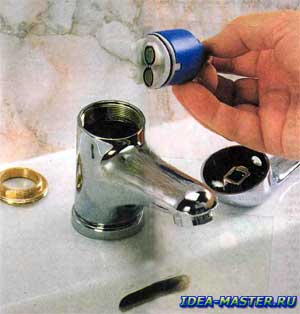 In recent years, single-lever mixers, characterized by increased durability and ease of operation compared to traditional ones, have been increasingly used.
In recent years, single-lever mixers, characterized by increased durability and ease of operation compared to traditional ones, have been increasingly used.
Installation and repair of a single lever mixer
The reasons for the growing popularity of single-lever mixers (in the literature you can find their other names — monocommand, articulated, single-arm and even — joysticks) lie in their design. Instead of the two usual valve heads in such mixers, as can be seen from their name, there is only one handle (lever). By turning this handle, the water supply is controlled, not only by the intensity of the flow (as it happens in a conventional faucet), but also by its temperature (as in a mixer).
The single lever mixer allows you to increase or decrease the water supply without changing its temperature. This is due to the fact that the temperature and water flow are regulated by different turns of the handle in the direction. To change the temperature, the lever must be turned left-right, and the pressure changes when the handle is deflected up-down. The full opening of the tap and switching from the supply of only cold water to the supply of only hot water occurs with relatively small turns of the mixer lever, which is also very convenient.
Long service life single lever mixers is primarily due to the fact that they lack metal rubbing parts (in the valve head — the stem and housing), and also rubber and other seals between moving parts (in the valve head — valve gasket and oil seal). These fast-wearing elements in the single-team mixer are replaced with high-strength ceramic parts. The tightness between the moving ceramic parts is ensured by high precision and purity of processing of the touching surfaces.
The only thing that can damage the ceramic elements of the mixer is mechanical impurities contained in tap water. Simply put, sand, rust and other abrasive particles entering the mixer with water can quickly disable this device, which is almost eternal under normal conditions.
The designers, of course, took into account such situations and provided a built-in filter in single-arm mixers. However, the quality of our water is so low that a small filter can not cope with its purification. In this case, the best solution would be to install a mechanical cleaning main filter at the entrance of the water pipe into the house or apartment.
When buying new plumbing — the first, and probably the most important thing that attracts attention is the appearance of the products. And in this one-lever mixers can safely be considered the undisputed leaders. Their design is modern and «technological». The cases of most models do not have visible seams, the shapes differ in streamlining and smooth transitions. Chrome plating, nickel plating, various types of color coatings are used in the finishing of the external surfaces of faucets, for example, the now fashionable black finish, sometimes called «black gold». Such a variety of shapes and finishes makes it easy to choose a single lever mixer for any kitchen or bathroom interior.
According to the design, single-lever faucets, like conventional valve faucets, can be divided into devices designed for kitchen sinks and washbasins and devices with a «spout-shower» switch and an appropriate outlet for connecting the shower. The latter are installed in bathrooms. The spout of most single-lever faucets is made at the same time with the body, but there are models for a bath and a washbasin with a long rotary spout.
The handle of a serviceable crane turns smoothly, without noticeable jams and passes. If grains of sand constantly get inside the mixer head, the tightness is broken: when the tap is turned on, the grains of sand, like mini-cutters, make small grooves in the lapped surfaces of the ceramic parts of the head, which, unfortunately, will eventually be enough for the tap to leak. And if such a misfortune has happened, nothing can be done, the head will have to be changed, since it is almost impossible to eliminate this defect (grooves on the rubbing ceramic parts of the crane) at home.
The only thing you need to know for sure when purchasing a new head (cartridge) is its type. There are not so many of them, but they differ from each other both in dimensions and in the shape of the landing (connecting) surfaces. The positive thing is that there is a unification of cartridges by type, that is, the same type of cartridges are suitable for any corresponding tap, regardless of the manufacturer. The cartridge is much cheaper than a new mixer. Therefore, it makes perfect sense, even just in case, to master the simplest techniques for replacing it: they are almost the same for different cranes, the difference may be in the attachment of the lever (crane handle).
Single lever mixer cartridge replacement
(Don't forget to shut off the water supply before starting work.)
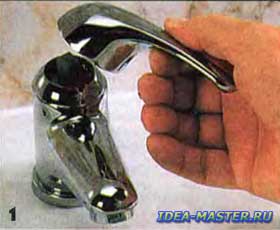 1. Unscrew the screw fixing the mixer lever on the rod and remove the lever. |
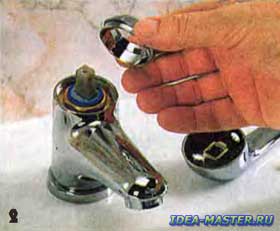 2. Now you can remove the chrome decorative cover that sits freely in the case. |
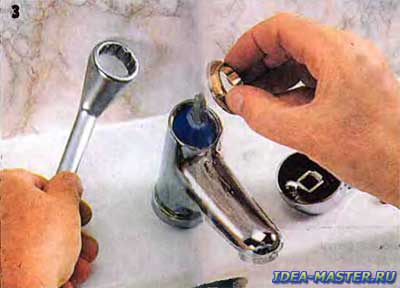 3. A brass clamping nut is unscrewed with a cap wrench, which fixes the cartridge (blue) in the mixer housing with a built-in mechanical filter. |
|
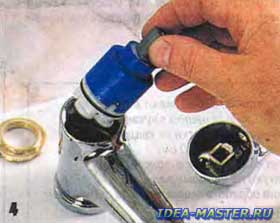 4. Remove the old cartridge from the case. Preventive disassembly of the mixer can be performed simply to check the condition and clean the built-in mechanical filter. |
 5. Before installing the cartridge in place, the inner surfaces of the case are wiped with a soft cloth. The mixer is assembled in reverse order. |
In the section «Repair and construction»
| Share this page on social networks: |
